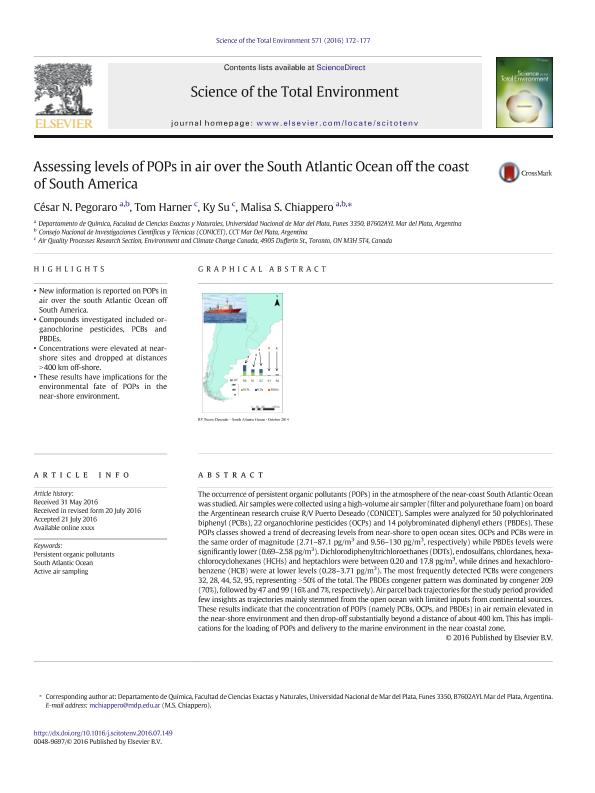Mostrar el registro sencillo del ítem
dc.contributor.author
Pegoraro, César Nicolás

dc.contributor.author
Harner, Tom
dc.contributor.author
Su, Ky
dc.contributor.author
Chiappero, Malisa Susana

dc.date.available
2019-12-09T17:57:30Z
dc.date.issued
2016-11
dc.identifier.citation
Pegoraro, César Nicolás; Harner, Tom; Su, Ky; Chiappero, Malisa Susana; Assessing levels of POPs in air over the South Atlantic Ocean off the coast of South America; Elsevier Science; Science of the Total Environment; 571; 11-2016; 172-177
dc.identifier.issn
0048-9697
dc.identifier.uri
http://hdl.handle.net/11336/91732
dc.description.abstract
The occurrence of persistent organic pollutants (POPs) in the atmosphere of the near-coast South Atlantic Ocean was studied. Air samples were collected using a high-volume air sampler (filter and polyurethane foam) on board the Argentinean research cruise R/V Puerto Deseado (CONICET). Samples were analyzed for 50 polychlorinated biphenyl (PCBs), 22 organochlorine pesticides (OCPs) and 14 polybrominated diphenyl ethers (PBDEs). These POPs classes showed a trend of decreasing levels from near-shore to open ocean sites. OCPs and PCBs were in the same order of magnitude (2.71–87.1 pg/m3 and 9.56–130 pg/m3, respectively) while PBDEs levels were significantly lower (0.69–2.58 pg/m3). Dichlorodiphenyltrichloroethanes (DDTs), endosulfans, chlordanes, hexachlorocyclohexanes (HCHs) and heptachlors were between 0.20 and 17.8 pg/m3, while drines and hexachlorobenzene (HCB) were at lower levels (0.28–3.71 pg/m3). The most frequently detected PCBs were congeners 32, 28, 44, 52, 95, representing > 50% of the total. The PBDEs congener pattern was dominated by congener 209 (70%), followed by 47 and 99 (16% and 7%, respectively). Air parcel back trajectories for the study period provided few insights as trajectories mainly stemmed from the open ocean with limited inputs from continental sources. These results indicate that the concentration of POPs (namely PCBs, OCPs, and PBDEs) in air remain elevated in the near-shore environment and then drop-off substantially beyond a distance of about 400 km. This has implications for the loading of POPs and delivery to the marine environment in the near coastal zone.
dc.format
application/pdf
dc.language.iso
eng
dc.publisher
Elsevier Science

dc.rights
info:eu-repo/semantics/openAccess
dc.rights.uri
https://creativecommons.org/licenses/by-nc-sa/2.5/ar/
dc.subject
ACTIVE AIR SAMPLING
dc.subject
PERSISTENT ORGANIC POLLUTANTS
dc.subject
SOUTH ATLANTIC OCEAN
dc.subject.classification
Otras Ciencias de la Tierra y relacionadas con el Medio Ambiente

dc.subject.classification
Ciencias de la Tierra y relacionadas con el Medio Ambiente

dc.subject.classification
CIENCIAS NATURALES Y EXACTAS

dc.title
Assessing levels of POPs in air over the South Atlantic Ocean off the coast of South America
dc.type
info:eu-repo/semantics/article
dc.type
info:ar-repo/semantics/artículo
dc.type
info:eu-repo/semantics/publishedVersion
dc.date.updated
2019-12-05T18:05:29Z
dc.journal.volume
571
dc.journal.pagination
172-177
dc.journal.pais
Países Bajos

dc.journal.ciudad
Amsterdam
dc.description.fil
Fil: Pegoraro, César Nicolás. Consejo Nacional de Investigaciones Científicas y Técnicas; Argentina. Universidad Nacional de Mar del Plata. Facultad de Ciencias Exactas y Naturales. Departamento de Química; Argentina
dc.description.fil
Fil: Harner, Tom. Environment and Climate Change Canada; Canadá
dc.description.fil
Fil: Su, Ky. Environment and Climate Change Canada; Canadá
dc.description.fil
Fil: Chiappero, Malisa Susana. Consejo Nacional de Investigaciones Científicas y Técnicas; Argentina. Universidad Nacional de Mar del Plata. Facultad de Ciencias Exactas y Naturales. Departamento de Química; Argentina
dc.journal.title
Science of the Total Environment

dc.relation.alternativeid
info:eu-repo/semantics/altIdentifier/url/https://www.sciencedirect.com/science/article/pii/S004896971631600X
dc.relation.alternativeid
info:eu-repo/semantics/altIdentifier/doi/http://dx.doi.org/10.1016/j.scitotenv.2016.07.149
Archivos asociados
